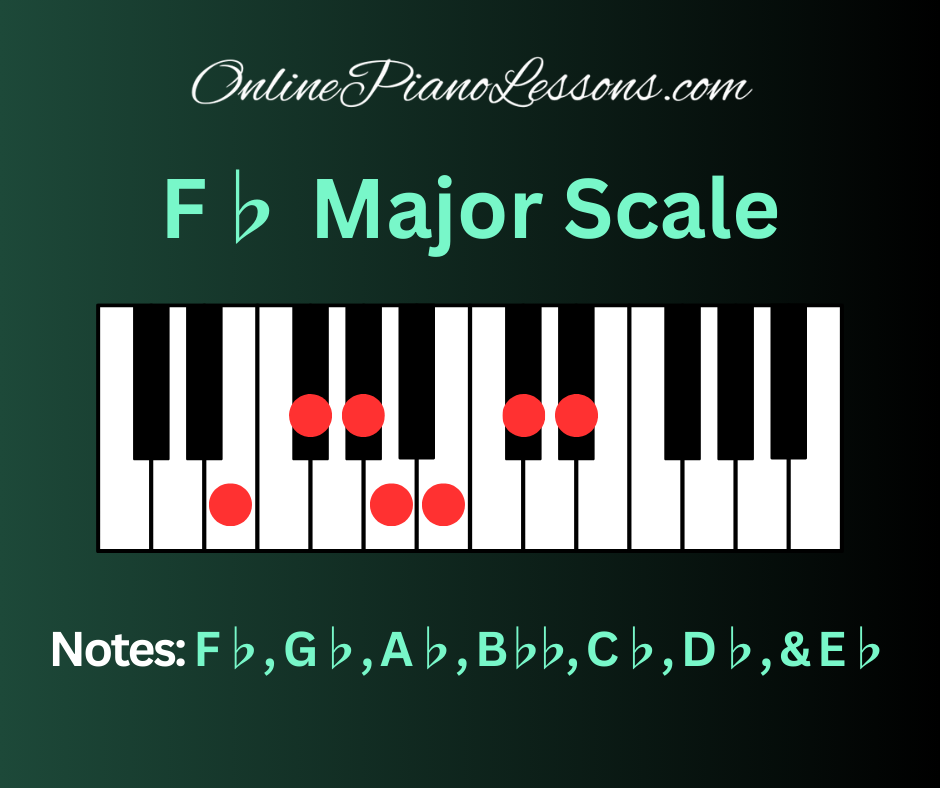
The F flat major scale is one of the most unusual yet fascinating keys in Western music. Although the F♭ major scale is enharmonically identical to the more familiar E major, it serves a distinct theoretical and harmonic purpose in certain compositions. For pianists, learning the F flat major scale is an opportunity to deepen your understanding of how keys function, how notation impacts interpretation, and how musical context shapes the way we perform on the piano.
This definitive guide will walk you through what the F flat major scale is, how to find it, how it works, how it sounds, and how you can internalize it confidently on the piano—even though its physical layout is the same as playing E major. By the end of this guide, you’ll understand why the F♭ major scale exists, when composers use it, and how to master it with accuracy and ease.
What Is The F Flat Major Scale?
The F flat major scale is a major scale beginning on the note F♭ rather than on F natural. While it may seem unusual, it follows the exact same whole step–whole step–half step–whole step–whole step–whole step–half step pattern as every major scale.
The eight notes of the F♭ major scale are:
F♭ – G♭ – A♭ – B♭♭ – C♭ – D♭ – E♭ – F♭
The presence of B♭♭ and C♭ highlights why this key is so rarely used, and yet these notes are theoretically essential: every major scale must contain each letter name exactly once. That means the F flat major scale cannot replace B♭♭ with A or C♭ with B—even though they sound the same on the piano.
Enharmonically, this entire scale sounds identical to the E major scale on the piano.
But theoretically, the F♭ major scale exists to support particular harmonic and voice-leading functions.
Why Does The F Flat Major Scale Exist?
If the F flat major scale sounds the same as E major, why use it at all?
There are several important reasons:
1. Harmonic Continuity
Some compositions modulate from keys with many flats (such as G♭ major or D♭ major) into a theoretical key that should be spelled with flats to maintain consistency. In these cases, the F♭ major scale is the correct notation, not E major.
2. Correct Interval Spelling
Music theory demands that intervals be spelled accurately. If a melodic line ascends from E♭ to F♭, that is a half step. If it were written as E♭ to E, the notation would incorrectly imply a unison motion.
Thus the F♭ major scale preserves proper theoretical structure.
3. Voice Leading
When composers write lines that hinge on flat-based chord progressions, the F♭ major scale keeps everything legible and consistent for performers.
Even if the piano player hears E major, reading the correct spellings matters in the score.
How To Find The F Flat Major Scale On The Piano
Even though its notation appears complex, finding the F♭ major scale on the piano is extremely easy:
- F♭ is the same as E natural
- G♭ is the same as F♯
- A♭ is A♭
- B♭♭ is the same as A natural
- C♭ is the same as B natural
- D♭ is D♭
- E♭ is E♭
- And F♭ is E again
Therefore, the F flat major scale on the piano is physically identical to the E major scale.
This is extremely helpful for pianists. You get all the benefits of learning E major physically, while also mastering the theoretical value of the F♭ major scale.
The Sound And Character Of The F Flat Major Scale
On the piano, the F flat major scale sounds exactly like E major—warm, bright, open, and spacious. However, its emotional character on the page may differ.
Composers use the F♭ major scale not for sonic difference, but for structural clarity. When the harmony surrounding the scale is deeply rooted in flat-based relationships, the F♭ major scale supports the notation better than an enharmonic rewrite.
For pianists, this key can feel:
- Smooth and luminous
- Balanced between warm and brilliant
- Resonant through the middle register
- Favorable for expressive legato lines
Even though your fingers play the familiar notes of E major, the theoretical frame of the F flat major scale gives structure to the score.
Fingering For The F Flat Major Scale
Because the F♭ major scale is played exactly like E major on the piano, the fingering is standard and ergonomic.
Right Hand Fingering
1 – 2 – 3 – 1 – 2 – 3 – 4 – 5 (one octave)
Left Hand Fingering
5 – 4 – 3 – 2 – 1 – 3 – 2 – 1 (one octave)
Despite its theoretical complexity, the F flat major scale is one of the more comfortable scales for the piano due to the involvement of multiple black keys—notated or not.
Practice the fingering slowly and evenly. Once comfortable, bring the hands together.
Chords Built From The F Flat Major Scale
The diatonic triads of the F♭ major scale are:
- I — F♭ major: F♭–A♭–C♭
- ii — G♭ minor: G♭–B♭♭–D♭
- iii — A♭ minor: A♭–C♭–E♭
- IV — B♭♭ major: B♭♭–D♭–F♭
- V — C♭ major: C♭–E♭–G♭
- vi — D♭ minor: D♭–F♭–A♭
- vii° — E♭ diminished: E♭–G♭–B♭♭
Enharmonically, these match the chords found in E major but spelled differently. For pianists, playing these chords from the F flat major scale is straightforward—reading them in sheet music is the more challenging part.
How To Practice The F Flat Major Scale Effectively
Here are several practical strategies for mastering the F♭ major scale on the piano:
1. Practice Slowly With Correct Names
Even if you physically play E major on the piano, speak or think the correct note spellings.
This builds theoretical fluency.
2. Drill The Scale In Different Rhythms
Use patterns such as:
- Long–short
- Short–long
- Triplets
- Groups of four
This strengthens your control of the F flat major scale.
3. Add Dynamics
Practice crescendo ascending and decrescendo descending.
4. Practice Arpeggios
F♭ major arpeggios reinforce the unusual spelling of the scale’s triad.
5. Include Scale Inversions And Broken Chords
This aligns your ear and hands with the harmonic function of the F♭ major scale.
6. Sight-Read Music Written In F♭
This is rare—but valuable.
Try rewriting short E major excerpts into F♭ major notation to challenge yourself.
Musical Context And Usage
While no major piano work is commonly printed in the F flat major scale, certain scenarios do call for it:
- Tonal analysis in advanced theory
- Enharmonic modulations
- Orchestral reductions where winds or brass prefer flat-based notation
- Situations where E major would cause confusing spellings of chord tones
Understanding these contexts helps pianists become stronger musicians, not just players of keys.
The F♭ major scale may be rare, but its theoretical usefulness is undeniable.
Why Pianists Should Learn The F Flat Major Scale
Even though the F♭ major scale is rarely used in everyday piano repertoire, learning it benefits you by:
- Improving your grasp of enharmonic equivalents
- Expanding your understanding of notation
- Strengthening your ability to handle difficult key signatures
- Preparing you for advanced theory, arranging, or composition
- Solidifying your technique through scales, arpeggios, and chords
Working with the F flat major scale also reinforces humility: not every key is written for convenience, but for correctness.
FAQ
Is the F flat major scale the same as E major?
Yes, on the piano the F♭ major scale sounds identical to E major, but the spelling is different.
Why would anyone use the F flat major scale?
It maintains theoretical accuracy in flat-heavy harmonic contexts, especially in advanced music.
Is the F flat major scale hard to play on the piano?
No. It’s physically one of the easiest major scales on the piano—because you play the notes of E major.
Does the F flat major scale appear in real music?
Rarely in printed piano scores, but it appears in theoretical work, modulation, and certain orchestral settings.
Should beginners learn the F♭ major scale?
Yes, once they understand easier keys. It is extremely helpful for understanding enharmonic logic.





 Hi, I'm Thomas, Pianist Composer,
Hi, I'm Thomas, Pianist Composer,  I love playing piano, creating new melodies and songs, and further developing my online piano course and making updates/additions to my site OnlinePianoLessons.com!
I love playing piano, creating new melodies and songs, and further developing my online piano course and making updates/additions to my site OnlinePianoLessons.com!  Now that is what I call fun!
Now that is what I call fun!





